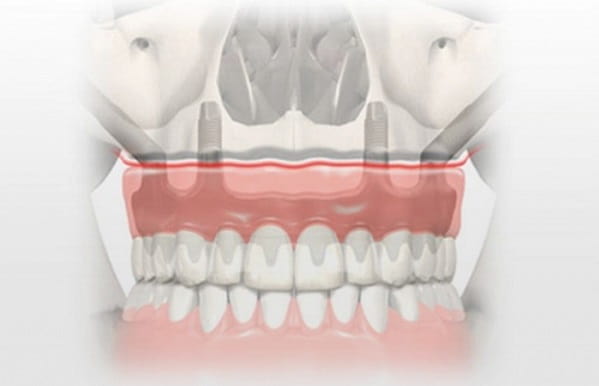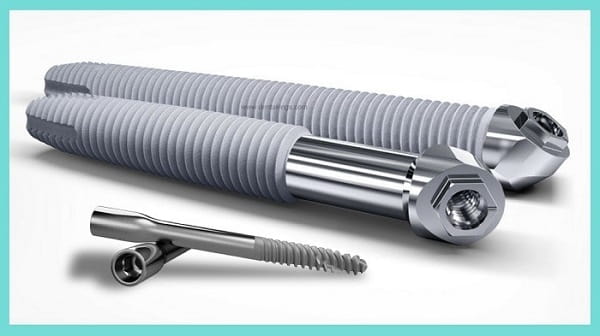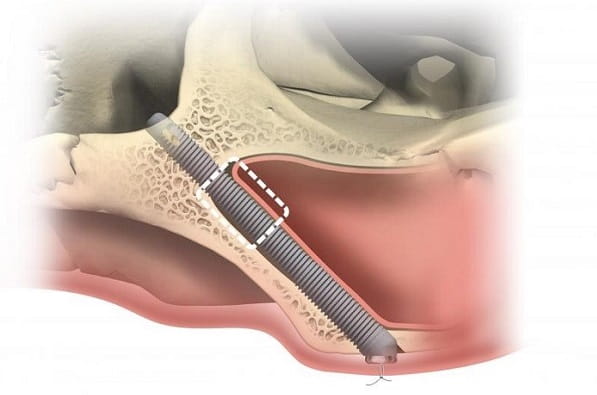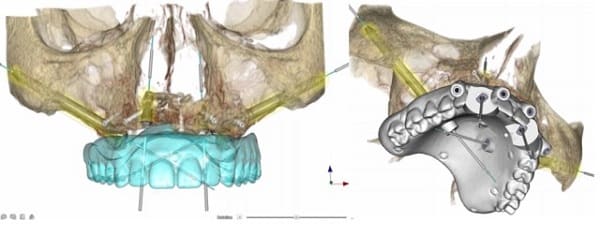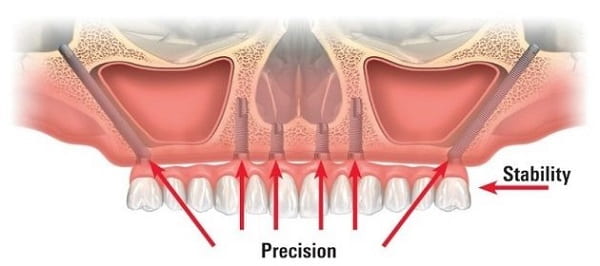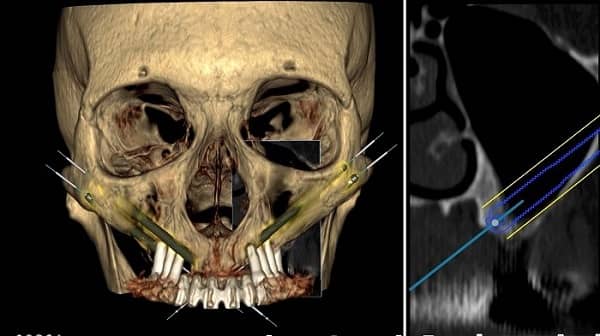If you have ever been told you don’t have enough bone for dental implants then our revolutionary zygomatic implants may be the solution for you. Depending on the outcome of your diagnostic x-rays, extra long dental implants may be offered in cases where the amount of bone available in the upper jaw is insufficient. These implants are called Zygomatic implants.
zygomatic dental implants extra-length secures the bridge into additional bone for better stability. The zygomatic dental implant procedure works by using the cheekbone to anchor implants, to which bridges and replacement teeth can be attached.
Depending on the extent of bone deterioration, 2 to 4 zygomatic implants will be used to support 4 to 8 ordinary implants. Fixed bridgework on top of the implants will hold the replacement teeth.
What are Zygomatic Implants?
Zygomatic Implants engage the very strong bulk of bone that forms the cheekbone. These innovative Dental Implants can be used as an alternative to complex bone grafting operations, making it possible to carry out surgery in just one simple stage.
After the surgical placement of the implants, we routinely fit a fixed resin bridge on the same day.
Previously patients would have endured several surgical graft treatments over 9-18 months in order to have the required bone to anchor an implant. These longer implants make grafting virtually unnecessary, and dentists have been able rid patients of their dentures in just one day.
Wearing traditional dentures can lead to a large loss of supporting bone and cause a ‘collapse’ or loss of face height. Zygomatic Implants corrects this loss of facial structure and can have a rejuvenating effect to the appearance of the face, especially for those patients who have worn dentures for a long time.
Why do you need zygomatic dental implants?
Dental implants need strong bone tissue to provide a stable foundation. Some people, particularly those who have had removable dentures for a long period may have lost the density in their jawbone to support implants. Zygomatic dental implants will provide a stable foundation to support tooth replacements and bridgework.
With the fixed implant your new teeth will be stable, durable and long-lasting, giving you the ability to function normally when chewing food, talking, smiling and maintaining oral hygiene. Your new teeth will need to be cared for like normal teeth through maintaining basic dental health.
If you have lost bone density in your jaw due to ageing, tumour or atrophy, you may have experienced some ‘collapsing’ in your face. The zygomatic dental implant procedure has the added benefit of improving the jaw structure and therefore improving your facial appearance.
Zygomatic implants have been documented as an alternative for the rehabilitation of the atrophic posterior maxilla with both the classical two stage and immediate loading protocols. Zygomatic implants avoid grafting and sinus lift procedures and therefore contribute to a shorter and more comfortable treatment. Further indications for zygomatic implants include failed conventional implant placement, failed sinus augmentation or grafting procedures, rehabilitation after tumor and trauma resections.
In the atrophic posterior maxilla, in general one zygomatic implant is placed on each side of the maxilla, in combination with 2-4 conventional implants in the anterior region.
For the totally resorbed maxilla, when placement of anterior implants is not possible the concept can be expanded by inserting 2 additional zygomatic implants in a more anterior position (Quad zygoma). Zygomatic implants nowadays are usually immediately loaded with a fixed bridge.
How does Zygomatic dental implants work?
The Zygomatic technique works by fixing the replacement bridge using only four dental implants as per normal however the two rear implants are extra-length
- The two front dental implants are at an angle to allow the bridge to be supported by the bone at the front of the jaw which is denser and stronger, without the risk of nerve damage.
- The two rear dental implants are extra-length and are surgically anchored to the ‘zygomatic’ arch, or the cheekbone, onto which crowns and dentures are attached.
- The dental bridge, designed, manufactured and fitted by our award-winning dental technician, is designed to look, feel and function like natural healthy teeth and gums.
Benefits of zygomatic implants
Although Zygomatic implants are considerably longer than conventional implants, the treatment is very similar from the patient’s perspective:
- Placement of Zygomatics is minimally invasive
- Dentists use image guided surgery for greater precision
- Dentists do not have to carry out a wide surgical exposure
- Dentists make the experience as comfortable as possible
- Treatment usually takes place under intravenous sedation
High primary stability for Immediate Function
zygomatic implants are designed to support restorative procedures that also allow for immediate loading. This allows eligible patients with severe bone loss to have a fixed provisional prosthesis fitted immediately after surgery, avoiding the average nine-month wait and multiple surgeries required with grafting.
the provisional prosthesis “has benefits for both the patient and clinician. The lack of compression of the post-operative soft tissue is more comfortable for the patient, as the prosthesis is supported by the implants and not by the soft tissue of the surgical site. Patients also benefit from improved self-esteem as the immediately loaded prosthesis does not move, allowing for more confident speech and enhanced appreciation of foods due to lack of palatal coverage.
For the clinician, the immediately loaded prosthesis provides practical feedback as to the ‘quality’ of the osseointegration at Stage II. If the implants are immobile at Stage II, then the clinician can confidently complete the final prosthesis.
Patients should always receive appropriate and comprehensive aftercare instructions for their immediately loaded prosthesis in order to help ensure the success of the treatment plan.”
Other benefits of Immediate Function with zygomatic implants include fewer clinical visits and a less invasive intervention compared to grafting procedures. A study has also shown that soft tissue clinical outcomes, in terms of plaque index, bleeding index and probing pocket depths, for zygomatic implants seem similar to those for conventional dental implants.
Surgical flexibility
Building on 25 years of success with Nobel Biocare’s zygomatic implants, the new NobelZygoma 0̊ and NobelZygoma 45̊ implants are also designed to anchor in zygomatic bone and provide an excellent option for treating maxillary resorption. They have an unthreaded implant body designed to interface with soft tissue, and depending on the anatomical situation parts of the implant body can be located outside of the maxillary sinus. For the extra-maxillary placement, the coronal part of the implant should still have bone support.
The straight implant head and mount-free insertion of the NobelZygoma 0̊ implant allow for greater flexibility during implant placement. The NobelZygoma 45̊ implant comes in an extended range of implant lengths, from 30 mm to 52.5 mm, all with an external hex connection.
these implants have three major benefits. First, they allow for high primary stability which is important for immediate loading. Second, the non-threaded part of the implant body acts well with soft tissue. Lastly, the two different angulations provide more flexibility for our prosthetic approach. This is a very important step forward in the zygomatic technique.
Helping treat more patients better
The zygomatic implant has become the implant of choice for cases with a severely resorbed maxilla. Without this implant, many patients would otherwise require invasive grafting procedures to establish adequate bone volume for the placement of conventional implants. Zygomatic implants help avoid grafting and shorten treatment time, with significant post-operative improvements in function and esthetics.
After zygomatic treatment the improvement in quality of life for the patient is dramatic. Before the treatment, these patients are orally handicapped, which can lead to a lot of psychological, social and functional problems. after the treatment quality of life can return to normal. It’s remarkable.
Minimising discomfort and anxiety
Dentists strive to make your treatment as painless as possible and so, to ensure your comfort throughout the zygomatic procedure, the treatment is carried out under intravenous sedation. specialist anaesthetists will ensure that any pain and discomfort are minimised during treatment.
Additional complex surgical procedures not required
There is no need for a complex bone grafting operation, which can take up to six months to heal and several procedures to have full working teeth.
The zygomatic dental implant procedure is carried out in just one stage – this includes the implant placement and the fixed bridge. The procedure has an immediate impact on your ability to bite and chew, and will give you great looking teeth, which, if cared for properly, will last a lifetime.
A Comprehensive Same Day Missing Teeth Treatment
Depending on bone availability dentists may only need to use one or two Zygomatic Implants, along with 2-4 ordinary dental implants to support the restoration.
In cases where bone has further diminished in availability, up to 4 Zygomatic Implants may be used to achieve a stable support for restorations.
In particularly challenging cases where the jaw is exceptionally damaged by advanced bone loss / destruction, dentists will design and make implants specifically for your particular situation.
Complications
The most common complication associated with zygomatic implants is sinusitis. Appropriate pre-surgical diagnostics and evaluation of the sinus as well as using the extra-sinus surgical approach and immediate loading of the implants seem to reduce or even eliminate this complication.
Other complications reported during and after the insertion of zygoma implants include infraorbital nerve paresthesia, orosinusal fistula and perforation of the orbit.
Prognosis
Long-term prospective studies with the classical 2-stage and immediate loading approaches document high success rates with only minimal complications. The cumulative survival rate of zygoma implants is 96% after 12 years.

